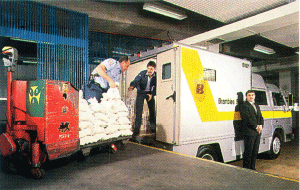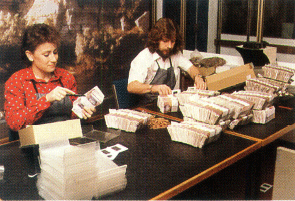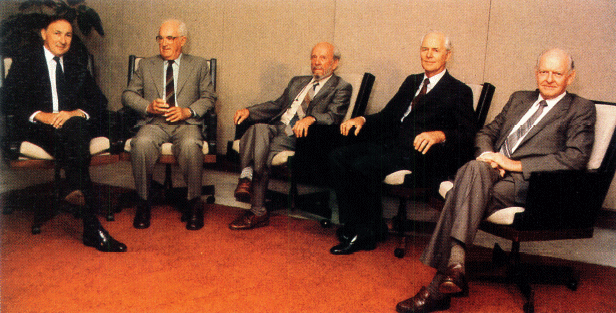Reserve Bank of Australia Annual Report – 1986 Branch Activities and Services
The Bank provides a range of financial services through its branches. These include banking facilities for governments and other customers, printing and issue of currency notes, cash services to banks, and registry facilities for holders of Commonwealth Government securities. The Bank is also expanding its information and related community services.
Branch Activities
Banking operations
The Bank is principal banker to the Commonwealth Government and a number of statutory authorities and conducts banking business for four State Governments. It also conducts accounts for a number of overseas central banks and international financial organisations, for the authorised dealers in the short term money market and for settlement of exchanges of the Australian banks. Through its Rural Credits Department it is currently banker to a number of statutory marketing boards and co-operative bodies. (But see below.)
Deregulation has provided scope to improve the banking services provided to customers. The Bank has been quick to take the opportunity to raise its banking services to the highest standards. Accordingly, it has kept under close review the systems and technology underlying these services.
Mainly because of the continuing trend for the Commonwealth Government to make payments (mainly welfare) directly to accounts of beneficiaries at banks or other financial institutions, there was a further sharp fall in 1985/86 in the volume of cheques drawn on the Bank. A total of 33 million cheques were paid during the past year, compared with 81 million in 1984/85 and 98 million in 1982/83.
Rural Credits Department
As announced in April 1986, the operations of the Rural Credits Department are being phased out. Transitional facilities are being provided to allow existing customers to have access to advances from the Department for one more commodity season.
Both the Committee of Inquiry into the Australian Financial System and the Australian Financial System Review Group recommended the phasing out of the Rural Credits Department. From the viewpoint of monetary policy it has been appropriate for the Bank to play a smaller direct part in rural financing. In recent years there has been a decline in the number of customers and in advances. In this period, interest rates charged by the Department have been brought into line with market rates and, with the development of financial market facilities, customers have been able to arrange alternative accommodation.
Over the past twelve months, the major commodities financed through the Department were dairy products, rice and cotton. Other commodities included superphosphate, canned and dried fruits, eggs, sugar and ginger.
Note printing
The Bank's Note Printing Branch at Craigieburn in Victoria produced a record 511 million pieces of Australian currency during 1985/86, 10 per cent more than in the previous year. As well, 13 million pieces of other security printing were produced.
The Bank is in close touch with other note printers abroad about technological developments which may improve the security and quality of currency notes as well as production efficiency. The Note Printing Branch itself is working on the development of a polymer-based form of note which it is hoped will improve the security and durability of the currency.
| At end June | $1 | $2 | $5 | $10 | $20 | $50 | $100 | All Notes |
|---|---|---|---|---|---|---|---|---|
| 1982 | 79 | 158 | 165 | 547 | 2,170 | 2,718 | — | 5,837 |
| 1983 | 82 | 164 | 176 | 536 | 2,213 | 3,243 | — | 6,414 |
| 1984 | 57 | 170 | 184 | 514 | 2,250 | 3,453 | 609 | 7,237 |
| 1985 | 45 | 179 | 194 | 522 | 2,312 | 3,430 | 1,552 | 8,234 |
| 1986 | 42 | 174 | 204 | 525 | 2,282 | 3,442 | 2,246 | 8,915 |
Cash operations
During 1985/86, net issues of currency notes amounted to $681 million. For the third consecutive year, the increase was very largely accounted for by the $100 note, which was first issued in March 1984. Further details are given in the table on page 41.
Additional high-speed currency verification, counting and sorting (CVCS) machines were installed during the year and further units will be introduced during 1986/87. These machines handle more effectively the task of maintaining an appropriate standard of notes in circulation by withdrawing notes passing through the machines which are worn, dirty or otherwise unsuitable for re-issue. They also assist with the detection of counterfeit notes.



Australian coin produced by the Royal Australian Mint is distributed by the Bank, which also takes in and re-issues existing coin. During the year it received from banks 2,084 million coins of all denominations, and issued 2,456 million.
Bonds and stock
The Bank provides a range of facilities related to Commonwealth Government securities. It manages domestic loan raisings for the Commonwealth Government and provides advice on debt management matters more generally. Full Registry facilities are available at each of the Bank's Australian branches.
In recent years, efforts have been made to improve services to investors in Commonwealth Government securities and to promote a deeper, more efficient secondary market. This has been a continuing process which should be greatly facilitated by the introduction of new computerised systems during 1986/87.
The Commonwealth Government made its first issues of indexed bonds during 1985/86. Four tenders of capital-indexed bonds were conducted by the Bank, involving $316 million in aggregate. Limited quantities of these bonds and also of interest-indexed bonds were made available on tap after each tender. Taking that into account, total holdings of indexed bonds at the end of the year were $331 million. With capital-indexed securities, the capital value of the bond is indexed and a fixed interest rate is applied to the appreciating capital value. With interest-indexed securities, the rate of interest is adjusted in line with inflation. Indexation for both securities is based on movements in the consumer price index; interest is paid quarterly.
In November 1985 the practice of accepting small non-competitive bids at bond tenders was discontinued. In its place, a limited quantity of bonds is now available on tap for a short period after each tender.
At end June 1986 the face value of Commonwealth Government securities inscribed at all Australian Registries for private stockholders was $39.2 billion.
The secondary market for Treasury bonds expanded further during the year. Turnover, as measured by registered transfers, was $113 billion in 1985/86, an increase of 41 per cent over 1984/85.
Since 1976 the Bank has conducted a Register of Income Equalization Deposits on behalf of the Commonwealth Government. With some other changes in arrangements, the Department of Primary Industry has assumed this responsibility.
Services
Information services
The Bank recognises the importance of informing the public promptly and adequately about changes in its policies. More generally, it seeks to promote broader community understanding of its role and functions; deregulation has had a major effect on the business of the Bank and operating procedures are now significantly different.
The Bank provides information in a number of ways. Major publications include its Annual Report and its monthly Bulletin. The format of the Bulletin has changed in recent years. Each issue now contains items of recent economic news; each quarter there is a detailed commentary on financial markets and the Bank's operations in them and, each half year, an economic survey. Public addresses by the Governor and others are included and the Bank's press statements are reproduced. Articles of a more specialised and technical nature are published from time to time.
The Bank's Press Office is a central point of contact for the media and the public. A good deal of information is now provided through electronic media but the Office also handles enquiries directly.


Exhibitions and displays
During the year the Bank held exhibitions of historical material at its Sydney and Adelaide branches as part of its community relations programme. A permanent exhibition and display area for the Bank's collection of historic materials relating to Australia's currency notes is being planned for the Bank's Note Printing Branch.
Research grants
During the year the Bank approved 79 grants from the Rural Credits Development Fund (RCDF) for a wide range of research projects to be undertaken over the next three years. In addition, four fellowships were offered to senior researchers from Canada, the United Kingdom and United States to undertake studies for up to 12 months in Australia. The total value of these grants and fellowships was $3 million; these funds were provided from the net profits of the Rural Credits Department.
Around $3 million will be available to the Fund in 1986/87 from Rural Credits Department profits in 1985/86. This amount will be allocated in November 1986. Funding from the RCDF will cease when the Department is terminated. The Government has announced, however, that consideration will be given to means of supplementing funds available from other sources for rural research.
The Bank is also planning to publish an account of its policies and operations since 1945. This will follow on from Professor L.F. Giblin's “The Growth of a Central Bank”, which covered the period from 1924 to 1945. The work is being directed by Professor C.B. Schedvin, Professor of Economic History at the University of Melbourne.
Freedom of Information
Sixteen requests were received during the year for access to documents under the Freedom of Information Act.
Six of the requests were granted in full and some others in part. For those granted in part, the documents withheld were exempt documents or related to matters which are exempt from the operation of the Act. In six requests, access was not given to any documents; in one of these the Bank held no documents which were considered to be relevant to the request. Two internal reviews were conducted and some further documents were released.
The cost to the Bank of administering the Freedom of Information Act in 1985/86, including staff and overheads, is estimated to have been approximately $24,000.
